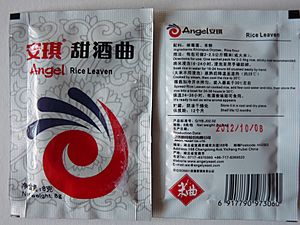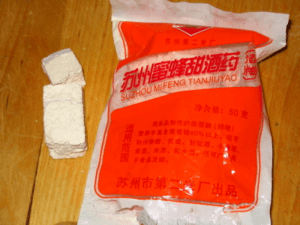Jiuniang facts for kids

A bowl of guihua jiuniang (桂花酒酿; 桂花酒釀)
|
|
| Type | Rice pudding |
|---|---|
| Place of origin | China |
| Region or state | East Asia |
| Main ingredients | Glutinous rice, fermentation starter (yeast and Aspergillus oryzae) |
| Jiuniang | |||||||||||||||
|---|---|---|---|---|---|---|---|---|---|---|---|---|---|---|---|
| Traditional Chinese | 酒釀 | ||||||||||||||
| Simplified Chinese | 酒酿 | ||||||||||||||
| Hanyu Pinyin | jiǔniàng | ||||||||||||||
| Literal meaning | Wine brew | ||||||||||||||
|
|||||||||||||||
Jiuniang (simplified Chinese: 酒酿; traditional Chinese: 酒釀) is a sweet and tasty dish from China. It's a bit like a soup or a pudding. People also call it láozāo (醪糟), jiāngmǐjiǔ (江米酒), or tiánbáijiǔ (甜白酒) in some areas like Yunnan.
Jiuniang is sometimes called sweet wine or sweet rice wine. It's made from glutinous rice that has been partly fermented. This means tiny living things have worked on the rice. The dish has soft rice grains floating in a sweet liquid. It also has a very small amount of alcohol and a bit of a sour taste from lactic acid.
To make Jiuniang, people ferment glutinous rice using a special starter called Jiuqu (酒麴). This starter contains tiny molds like Rhizopus oryzae or Aspergillus oryzae, and often yeast and other helpful bacteria.
How Jiuniang Is Made
Jiuniang first came about as a step in making mijiu, which is a type of rice wine. Think of Jiuniang as an early stage of rice wine. It's rice that has started to ferment but hasn't fully turned into wine yet.
If you eat Jiuniang soon after it's made, or keep it cool (below 10 degrees Celsius), the fermentation stops. This way, you get to enjoy it as Jiuniang. But if it gets warmer and the fermentation keeps going, Jiuniang will eventually become rice wine or even rice vinegar.
People often make and eat Jiuniang in the winter. This is because the cold weather helps to stop the fermentation easily. This keeps the Jiuniang sweet and delicious.
Sometimes, in Western stores, Jiuniang is called "rice sauce" or "rice wine" because of its small alcohol content. A popular kind of Jiuniang is made with sweet osmanthus flowers. This version is called guihua jiuniang (simplified Chinese: 桂花酒酿; traditional Chinese: 桂花酒釀).
How to Enjoy Jiuniang
Jiuniang is often served with small, plain tangyuan. These are little round rice balls. This is a common dish during the Dongzhi Festival, which is a Chinese winter holiday.
When served with tangyuan, the dish has different names:
- jiuniang tangyuan (酒酿汤圆; 酒釀湯圓)
- jiuniang yuanzi (酒酿圆子; 酒釀圓子)
- baijiu tangyuan (白酒汤圆; 白酒湯圓) in Yunnan
- If it has sweet osmanthus flowers, it's called guihua jiuniang tangyuan (桂花酒酿汤圆; 桂花酒釀湯圓).
No matter the name, you usually eat Jiuniang with a spoon, just like a soup or pudding.
Similar Dishes Around the World
There are many foods similar to Jiuniang in other parts of Asia.
- In the Philippines, it's called Binubudan.
- In Thailand, it's known as Khao Mak.
- In Malaysia or Indonesia, it's called Tapai. In Indonesia, a very popular type is made with purple or black glutinous rice, and it's called Tapai Ketan.
Jiuniang is also a bit like cơm rượu from southern Vietnam. This dish often has rice balls in it too. It's also similar to the Korean sikhye and Japanese amazake. However, these are usually thinner and are often thought of as drinks rather than soups or puddings.
See also
In Spanish: Jiuniang para niños



